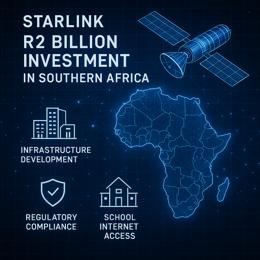Image created by AI
Revolutionary In-Flight Connectivity: The Promise of Starlink Wi-Fi on South African Flights
The skies over South Africa could soon witness a significant leap in in-flight connectivity, courtesy of SpaceX's Starlink Aviation. Known for its pioneering satellite Internet service, Starlink aims to transform the flying experience on several international airlines operating flights from South Africa. Despite the allure of high-speed internet skies, a crucial hurdle remains - the approval from the Independent Communications Authority of South Africa (ICASA).
Launched in October 2022, Starlink's aviation venture has already clinched partnerships with major global airlines, marking a robust entry into the aviation sector. According to statistics available on Starlink’s official site, its service is operational on over 55,000 flights, encompassing more than 110,000 hours in the air. Among the early adopters, Qatar Airways leads, having introduced Starlink Wi-Fi on select routes in October 2023. The airline plans a complete rollout on its Airbus A350 and Boeing 777 fleets by 2025, promising complimentary high-speed Wi-Fi to all passengers.
Adding to the momentum, United Airlines has committed to equipping over 1,000 aircraft with Starlink technology. The service will cater to their mainline and regional aircraft, enhancing connectivity on routes between South Africa and cities like Washington DC and New York. In a similar stride, Air France announced that from 2025 onwards, Starlink would become the backbone of connectivity across all its fleets, fully replacing the older geosynchronous (GEO) satellite systems.
The transition to Low Earth Orbit (LEO) technology by Starlink offers transformative advantages over traditional GEO satellite services, which suffer from higher latency and lower speeds. Orbiting at approximately 550 kilometers, Starlink's network of 6,700 satellites provides aircraft terminals with speeds ranging from 40Mbps to 220Mbps and latencies below 100ms. This infrastructure supports bandwidth-heavy applications like streaming, gaming, and video calling - a significant benefit over the standard pings of 600ms witnessed on GEO satellites.
While the technological infrastructure is ramping up, the looming question of regulatory approval remains. For the service to be operational within South African airspace, Starlink must secure permissions from ICASA. Until then, the service's availability will be limited to international waters and the skies of countries that have already given the nod, a list from which South Africa is notably absent.
Despite these regulatory hurdles, there exists a possibility for limited operation in South African skies, as Starlink's terms allow for service in overland flights above "most countries around the world." However, the specifics of these operations, including any potential need to disable service in restricted zones like South Africa, have not been detailed.
The expected integration of Starlink in popular airlines signals a significant shift towards enhanced passenger experience through superior connectivity. However, the full realization of this potential in South African skies hangs in the balance, pending local regulatory approval.










